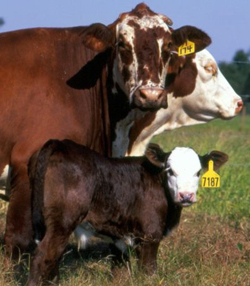Certified Calf Preconditioning: Are There Financial Incentives for Weaning Calves on the Ranch Prior to Shipping?

Seventeen years ago I was a student in the Animal Sciences Department at Purdue University. I can recall the first discussion that I participated in relative to the merits of calf preconditioning. Even at that time, I remembered how surprised I was of how little we understood of the financial advantages to this management procedure. Today, I continue to seek answers to this important concept. One of the major problems with the term "calf preconditioning" is that it means something different to everyone. Preconditioning is a generic term that refers to any of numerous management procedures that may be applied to a calf prior to shipping from the ranch or farm. These include, but are not limited to, castration, dehorning, creep feeding, weaning before shipping, and vaccination. Reasons that a cow/calf producer may wish to precondition their calves are numerous, but the underlying goal is to increase the value of the calf being sold or the productivity of the calf being retained. Unfortunately, the data supporting either of these goals is weak at best.
A recent publication from Colorado State University (JAVMA, Vol 229, No. 9, November 1, 2006) reviewed the impact of defined health programs on the sale price of beef calves marketed through a livestock video auction service. Their data includes 11 years of sales (1995 through 2005) and incorporates over 3 million feeder calves. To my knowledge this is the largest data set ever analyzed to evaluate the financial merits of calf preconditioning. Although the study analyzed several components relative to the value of preconditioned calves, I will review only two that are familiar management options among Florida cow/calf producers. These include the V34 program, which involves a pre-weaning administration at branding of a vaccine against 7 types of clostridia and at 2 to 4 weeks prior to shipping vaccines against IBR, PI3, BVDV, BRSV, and M haemolytica or P multocida (or both). The second program, V45, involves a very similar vaccination schedule (see report for specifics), but also involves booster vaccinations and the weaning of calves at the ranch for a minimum of 45 days before shipping. For many Florida cow/calf producers, these two preconditioning programs are commonly discussed, but the financial rewards for adopting one over the other has not been well understood.
The results of this study are revealing. The average weight of all calves in the study was 575 lb, a common weaning weight target for Florida cow/calf producers. Calves enrolled in these preconditioning programs were valued at approximately $14 and $38 more per head than calves with no Certified preconditioning program. The costs associated with the purchase of vaccines are an important, but highly variable factor. Among other things, this price variability is based upon the volume of product purchased and differences among specific brand types. A general cost of product between the two systems can be assessed at $3.25 and $4.75 per calf for V34 and V45 programs, respectively. As we examine these figures, it appears very likely that the V34 program (or other similar preconditioning programs) provides a positive financial return to the cow/calf producer. Less the costs of product, the average premium paid for V34 calves exceeds $10 per calf. The net return to the producer would be this premium less additional labor costs associated with working the calves and the variable costs associated with vaccination equipment.
Now, let's examine the value of the V45 program. On average, the sale price of the V45 calves was about $24 more than the V34 calves. Less the estimated costs of additional vaccine products needed to qualify for the V45 program, the average premium was about $19.25 over the V34 calves. The net return to the producer would be this premium less the labor costs associated with working the calves (at least one additional time to V34) and the variable costs associated with vaccination equipment and feed and management for the 45 days they will remain on the ranch prior to shipping. When these considerations are examined, the financial merit of the V45 program becomes troublesome. In our experiences, the V45 calves consume an average of 10 lb of feed daily when managed on good pastures for 45 days prior to shipping. Feed costs have typically averaged $40 to $60 per calf depending on annual prices of grain and delivery options (bulk or bagged). There is also death loss to consider. A load of calves (85 calves at 575 lb) ready to be shipped on the V34 program, but kept on the ranch for 45 days may experience some loss. Our annual average is 1.75% (1 to 2 calves per year). These costs must also be considered. Compared to the V34 program, V45 calves are costing the producer an additional $60 for feed, death loss, and additional vaccine. Averaged over 11 years on the sale of 3 million calves, this $60 investment has returned about $24. Even if a producer's feed and labor options are much less than average, the margin of loss represented here may be difficult to overcome.
The V34 / V45 comparison above is unique to cow/calf producers marketing truckload lots of calves. The ability to achieve this marketing threshold provides significant value and flexibility to the cow/calf producer. For producers unable to market truckload quantities, the V45 program, and other similar Certified Preconditioning programs, offers opportunities for producers to commingle groups of calves to achieve truckload lots. In these situations, the added value of weaning the calf on the ranch prior to marketing may be greater than the examples described above. Further, as the value of V34 calves has remained fairly steady, the value of V45 calves in this study increased in the later years of data collection. This response may indicate that feeder calf buyers may be beginning to place more value on calves weaned at the ranch prior to shipping.

